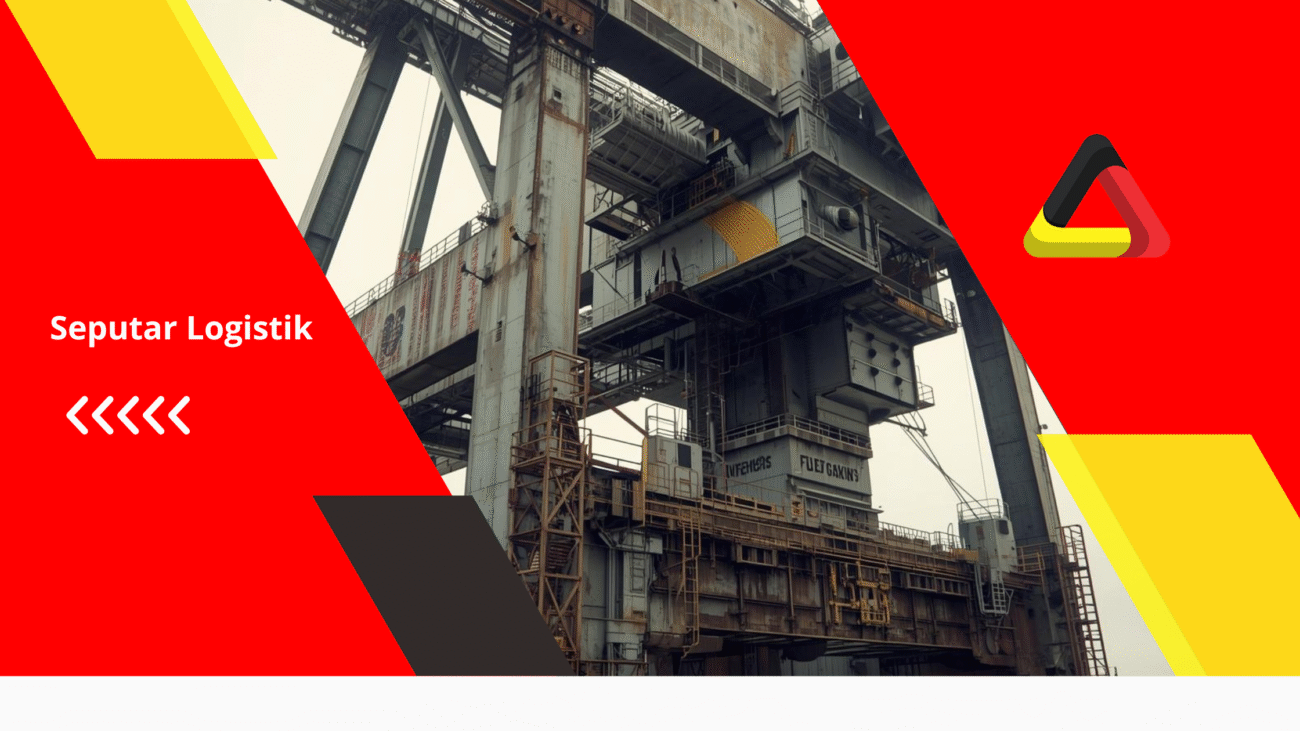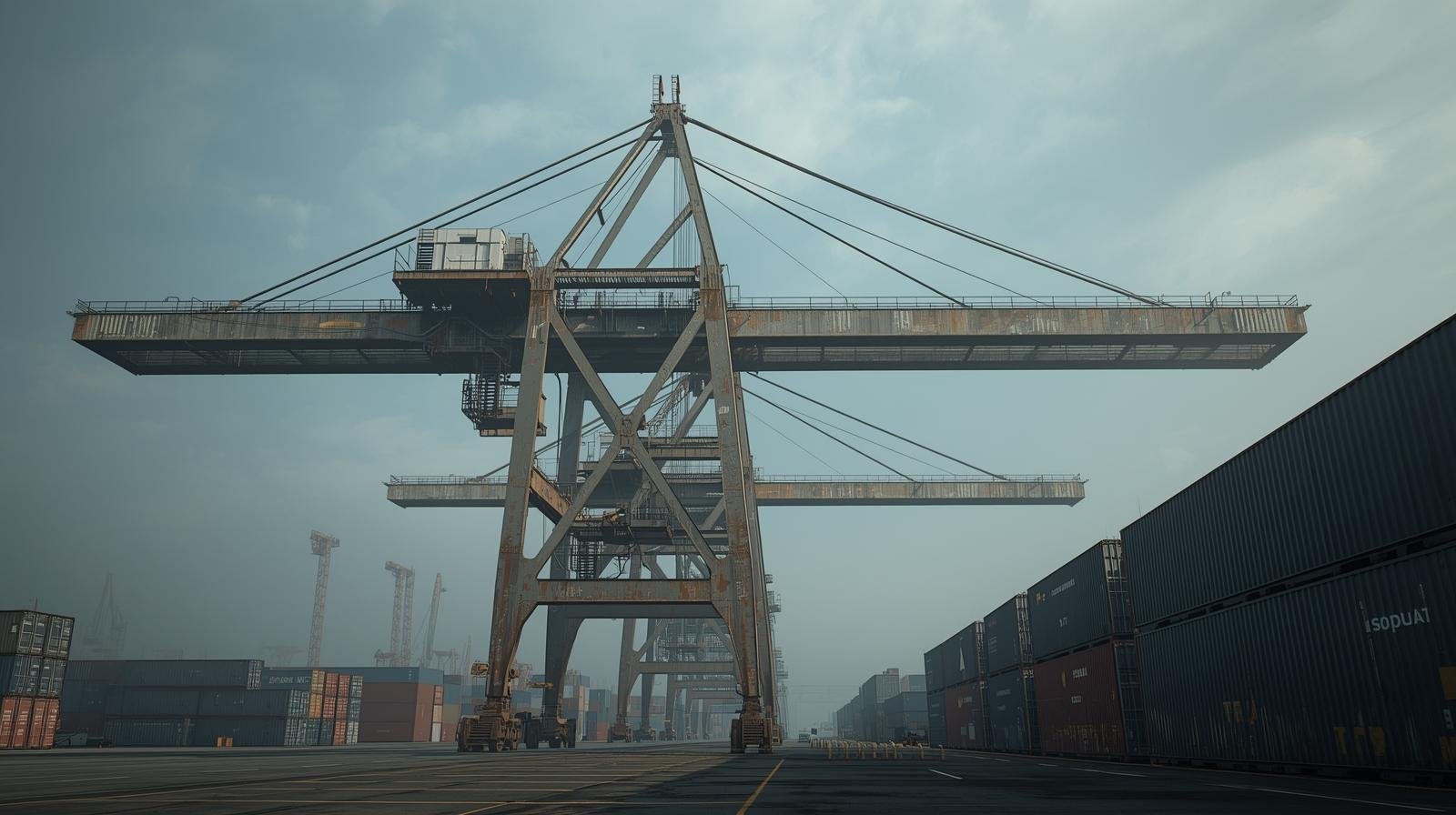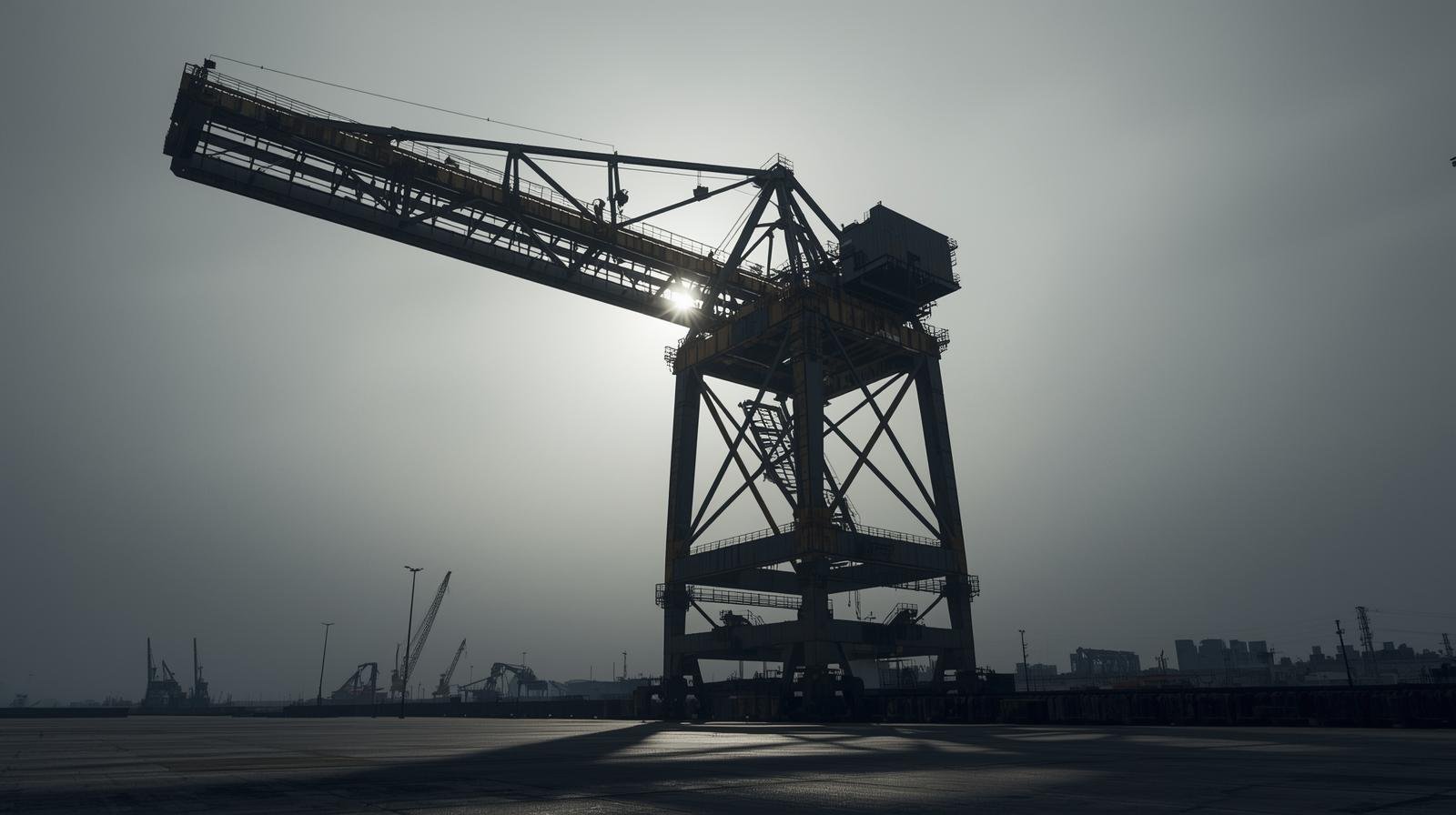Kalau kamu pernah lihat foto atau video pelabuhan yang busy, terutama port yang besar, pasti ada satu image yang super iconic dan memorable: mesin-mesin besar yang looks like giant robots dengan lengan panjang yang stretching across the port, mengangkat kontainer setinggi langit. Itu adalah gantry crane, atau yang sering disebut juga sebagai STS (Ship To Shore) crane kalau di konteks pelabuhan. Mesin ini adalah absolute workhorse dalam industri shipping dan logistics global. Tapi apa sih gantry crane? Bagaimana cara kerjanya? Dan kenapa itu menjadi investment yang massive tapi completely essential untuk setiap pelabuhan modern?
Apa Itu Gantry Crane?
Gantry crane adalah sebuah struktur crane berbentuk portal atau gantri—imagine a giant rectangular frame standing over a ship atau container yard. Crane ini designed khusus untuk lifting, moving, dan placing kontainer dari kapal ke dermaga (quay) atau sebaliknya, dan juga bisa untuk stacking di yard.
Nama “gantry” itu sendiri comes dari structure-nya—it looks like a gantry atau portal yang massive. Di dalam industri maritime, gantry crane lebih sering disebut “STS crane” ketika berada di quay untuk handle kapal, atau “RTG crane” (Rubber Tyred Gantry) ketika berada di yard untuk stacking containers di darat.
Yang membuat gantry crane special dibanding dengan crane lainnya adalah combination dari beberapa hal: jangkauan yang massive, lifting capacity yang huge, precision yang tinggi, dan speed operasional yang impressive. Sebuah gantry crane bisa angkat kontainer 40-tonnan dalam hitungan menit, move-nya across the ship smoothly, dan stack-nya dengan precision yang tidak ada kompromi.
Tipe-Tipe Gantry Crane
Nggak semua gantry crane itu sama. Ada beberapa classification tergantung lokasi dan fungsinya:
Ship To Shore Crane (STS Crane):
Ini adalah type yang paling familiar bagi orang yang lihat dari luar. STS crane berada di quay (dermaga) dan specifically designed untuk transfer containers antara kapal dan dock. Crane ini punya reach yang super jauh—bisa sampai 20+ rows of containers di kapal. Biasanya twin-lift capable, meaning bisa simultaneously lift dua 20-foot containers atau satu 40-foot container.
STS crane massive. Height-nya bisa sampai 50+ meter di atas permukaan deck, dan horizontal reach bisa sampai 50+ meter. Dengan dimensions yang segede itu, jangan bayangkan bisa digerakin seperti crane biasa. STS crane permanently installed di quay dan punya rubber-tyred wheels atau rail-mounted system untuk movement sepanjang dermaga.
Rubber Tyred Gantry Crane (RTG):
Kalau STS crane itu fixed atau mobile tapi along the quay, RTG crane adalah mobile gantry yang bisa roam freely di container yard. RTG mounted pada rubber tires (bukan rail), sehingga bisa move dalam semua arah—forward, backward, sideways.
Baca juga: Cara Cek Ongkir Cargo Minimal 100Kg ke Wilayah Timur
RTG ini lebih flexible dibanding STS crane dalam terms of positioning. Operator bisa move RTG ke mana saja di yard sesuai kebutuhan. RTG usually smaller daripada STS crane—typical height around 12-15 meters dan horizontal reach around 25-30 meters. Capacity-nya juga generally smaller, typically single-lift capable untuk satu 40-foot container.
Rail-Mounted Gantry Crane (RMG):
Ini adalah type yang literally mounted pada tracks atau rails. RMG sama like RTG dalam functionality, but movement-nya restricted sepanjang rails only. Keuntungan dari RMG adalah precision movement dan lebih efficient energy-wise. Disadvantage-nya adalah flexibility—bisa gerak hanya along the predetermined path.
Cantilever Gantry Crane:
Ini adalah modification dari standard gantry design di mana salah satu side extended out sebagai cantilever, extending reach beyond normal portal width. Cantilever design ini useful untuk accessing containers di posisi yang unusual atau untuk reach beyond the standard footprint.
Transfer Crane (Transtainer):
Technically bukan gantry dalam strict sense, tapi ini adalah hybrid antara gantry dan forklift. Transfer crane bisa move dalam dua dimensions dan bisa lift containers untuk transfer antara kapal ke truck atau rail cars di dock area. Operasi-nya more flexible tapi dengan trade-off dari stability dan lifting capacity yang lebih kecil dibanding traditional gantry.
Komponen-Komponen Utama Gantry Crane
Untuk understand gimana gantry crane bekerja, kita perlu understand components utamanya:
Portal Frame (Gantry Structure):
Ini adalah backbone dari crane. Portal frame made dari steel yang high-strength dan usually tetap stationery (untuk STS) atau moveable (untuk RTG/RMG). Frame ini terdiri dari two vertical legs yang connected oleh horizontal members, creating a rectangular portal shape. Design-nya calculated untuk handle massive loads sambil maintain structural integrity.
Hoist Mechanism:
Ini adalah system yang actually lift kontainer. Hoist mechanism terdiri dari motor listrik yang powerful yang drive mechanical system—usually pulley dan cable atau modern systems yang use strand jacks. Hoist bisa bergerak horizontal sepanjang the spreader bar, allowing untuk positioning yang precise.
Spreader Bar:
Ini adalah attachment yang actually connect dengan container. Spreader bar biasanya 40 feet atau 20 feet long (depending on capacity), dan equipped dengan four corner casting locks yang automatically engage dengan kontainer’s corner castings. Modern spreader bars fully automated—locks engage dan disengage dengan simple button press dari operator.
Trolley:
Trolley adalah carriage yang hold the hoist mechanism dan move horizontal across the gantry structure. Trolley travel along rails atau beams yang integrated dalam gantry frame. Movement-nya controlled oleh motor listrik yang precise. Speed-nya biasanya dapat diatur tergantung kebutuhan—slow untuk precision positioning, fast untuk efficiency.
Motor dan Power System:
Gantry crane powered oleh electric motors—biasanya multiple motors untuk different functions. Ada motor untuk hoist (lift), motor untuk trolley (horizontal movement), dan motor untuk gantry movement itself (kalau mobile). Power supply usually come dari shore-based electrical infrastructure untuk STS crane, atau dari on-board generator untuk RTG/RMG.
Control System dan Cabin:
Operator sitting di cabin yang usually positioned relatif high untuk good visibility. Cabin equipped dengan control panels, monitors, at some modern cranes, remote-operation capability. Modern control systems punya sophisticated sensors, cameras, dan even GPS positioning untuk ensure accurate placement.
Structural Steel dan Paint:
Gantry crane constantly exposed terhadap harsh maritime environment—salt spray, humidity, UV rays. Karena itu, material selection dan protective coating absolutely critical. Steel quality harus high-grade, dan paint system harus marine-grade dengan multiple layers untuk protect against corrosion.
Baca juga: Reach Staker 101: Cara Kerja, Manfaat dan Risiko
Bagaimana Gantry Crane Beroperasi
Proses operasional gantry crane involves several coordinated steps:
Pre-Operation Check:
Seperti semua heavy equipment, operator mesti start dengan thorough pre-operation check. Ini termasuk visual inspection dari struktur, checking hydraulic dan electrical systems, testing semua controls untuk responsiveness, dan ensure spreader bar dalam good condition.
Positioning Crane:
Untuk STS crane, crane position-nya predetermined based on di mana kapal bertie. Untuk RTG/RMG, operator need to position crane directly above atau near the container stack yang akan di-handle. Positioning ini critical—salah sedikit bisa lead ke inefficiency atau damage.
Positioning Trolley dan Spreader Bar:
Once crane positioned, trolley move ke lokasi yang tepat di atas kontainer yang akan diangkat. Spreader bar lower down slowly sehingga corner locks align perfectly dengan container corner castings.
Engagement dan Locking:
Spreader bar locks engage, securing kontainer ke bar. Ini biasanya automatic di modern systems—sensors detect proper alignment, locks engage automatically. Some older systems require manual engagement, which lebih time-consuming dan riskier.
Lifting:
Once secured, hoist motor activate untuk lift kontainer. Lifting speed biasanya tightly controlled—usually around 100-150 meters per minute untuk loaded lift. Operator monitor load constantly untuk ensure balanced lifting dan no swinging.
Horizontal Movement:
With kontainer lifted, trolley move horizontally untuk position kontainer above destination. Movement ini smooth dan controlled—any jerky movement bisa cause swinging yang dangerous atau container damage.
Vertical Positioning:
Setelah horizontal positioning complete, kontainer lowered ke target location—might be another spot di kapal, atau di stack area di yard, atau di truck chassis yang waiting di bawah. Lowering juga carefully controlled untuk ensure smooth placement.
Disengagement dan Release:
Once kontainer settled pada target location, locks disengage dan kontainer now rest pada its new position. Spreader bar kemudian raised, free untuk handle kontainer berikutnya.
Repeat Cycle:
Gantry crane then return ke pick-up position untuk handle next container. Cycle ini bisa repeat ribuan kali per hari, tergantung pada crane utilization dan operational needs.
Kapasitas dan Spesifikasi Typical
Untuk give you sense dari scale gantry crane:
STS Crane (Ship To Shore):
Typical STS crane bisa lift 65 ton (dapat handle dua 20-ft containers atau satu 40-ft container). Height above water level bisa reach 50+ meters. Horizontal outreach bisa 50+ meters atau lebih, depending pada berapa wide the ship yang di-serve. Operational speed impressive—bisa 100+ lift cycles per hour kalau well-coordinated.
RTG Crane (Rubber Tyred Gantry):
RTG biasanya punya capacity 40-65 ton untuk single lift. Height biasanya 12-15 meters untuk standard stack configuration. Horizontal reach typically 25-30 meters. RTG slower daripada STS dalam terms of lift speed, tapi more flexible dalam positioning.
RMG Crane (Rail-Mounted Gantry):
Similar specifications dengan RTG, tapi dengan advantage dari precision karena rail-guided movement. Speed bisa slightly faster dibanding RTG karena reduced friction dan more predictable movement patterns.
Efisiensi dan Productivity
Mengapa pelabuhan invest heavily dalam gantry crane? Karena efficiency dan productivity gains-nya massive:
High Throughput:
Sebuah modern STS crane bisa handle 30-40 container moves per hour. Multiply itu dengan berapa banyak cranes di satu pelabuhan, dan kamu talking about ribuan containers moved per day. Ini impossible untuk achieve dengan manual labor atau slower equipment.
Fast Turnaround:
Ships di port expensive—biaya untuk idle ship bisa mencapai ratusan ribu dollar per hari. Dengan gantry crane yang efficient, kapal bisa di-load dan di-unload dalam hitungan jam, significantly reducing port time dan associated costs.
Reduced Labor Requirements:
Modern gantry cranes fully automated atau semi-automated, reducing need untuk large labor force. Ini improve both economics dan safety—fewer people exposed ke heavy equipment operations.
Minimal Damage:
Dengan precision control dan modern spreader bar technology, damage terhadap containers minimal. Ini protect cargo dan reduce costly claims untuk damaged goods.
Scalability:
Port bisa increase capacity dengan add more cranes. Ini more flexible dibanding trying untuk scale up manual operations.
Baca juga: Apa Itu Quay Container Crane?
Tantangan dalam Operasi Gantry Crane
Despite advantages-nya, gantry crane operations juga punya challenges:
Extreme Weather Dependency:
Gantry cranes particularly vulnerable terhadap strong winds. Most STS cranes punya wind speed limits—biasanya antara 40-60 km/h—di mana operations harus suspended. Ini bisa cause significant delays, especially di regions dengan frequent storms.
Structural Fatigue:
Repeated stress dari lifting heavy loads cause gradual structural fatigue. Regular inspection dan maintenance absolutely critical untuk prevent catastrophic failure. Some cranes after 20-30 years operasi need major rehabilitation atau replacement.
Safety Risks:
Meski modern cranes punya safety features, accident masih bisa happen. Load dropping, cable breaking, operator error, atau structural failure bisa cause serious injuries atau fatalities. Proper training, maintenance, dan protocols essential.
High Capital Cost:
Brand new STS crane bisa cost $10-20 million atau lebih. Untuk RTG/RMG, cost still significant—usually di range $1-5 million. Ini massive investment, limiting access untuk smaller ports.
Space Constraints:
Di cramped ports, mungkin sulit untuk position gantry cranes efficiently. Layout optimization crucial tapi sometimes geometrically impossible dengan existing infrastructure.
Teknologi Modern dan Inovasi
Gantry crane technology terus evolve:
Automation dan Remote Operation:
Banyak modern cranes sekarang bisa operated remotely dari control center, sometimes even dari lokasi yang jauh. Ini reduce hazard exposure untuk operator at improve consistency.
Real-Time Data Monitoring:
Sensors track load, wind speed, structural stress, dan various other parameters. Data ini transmitted ke central system untuk analysis dan optimization. Predictive analytics bisa alert maintenance teams sebelum problems develop.
Wireless Communication:
Modern cranes equipped dengan reliable wireless systems untuk communicate antara operator, vessel coordinators, dan port operations. Ini significantly improve coordination dan safety.
Energy Efficiency:
Newer generation cranes increasingly punya regenerative systems yang capture energy saat lowering loaded containers, using energy ini untuk power other functions. Ini reduce overall energy consumption.
Environmental Considerations:
Some ports explore hybrid atau electric gantry cranes untuk reduce emissions. Battery technology improvements making this increasingly viable untuk lighter-duty applications.
Gantry Crane di Berbagai Negara
Different countries punya different standards dan specifications:
Asia (Khususnya China dan Singapore):
Asian ports generally punya most modern gantry crane infrastructure. China’s mega-ports like Shanghai and Shenzhen punya fleets dengan newest technology. Singapore’s port terminal facilities world-class standard.
Middle East:
Ports di UAE, Saudi Arabia, punya significant gantry crane investments untuk support growing container traffic. Gulf ports competitive dalam terms of crane technology dan efficiency.
Europe dan North America:
While modern, European at North American ports generally punya older infrastructure dibanding Asia. Retrofit at upgrade projects ongoing untuk maintain competitiveness.
Gantry Crane
Gantry crane adalah truly remarkable piece of engineering—kombinasi dari power, precision, at efficiency yang essential untuk modern maritime commerce. Dari its imposing visual presence sampai incredibly complex operations, gantry crane represents pinnacle dari industrial crane technology.
Untuk Indonesia, dengan growing port infrastructure di places seperti Jakarta, Surabaya, Makassar, at Batam, gantry crane menjadi increasingly important untuk enhance handling capacity at efficiency. Investment dalam modern crane technology tidak just about handling volume—ini about being competitive globally, reducing vessel turnaround times, at ultimately supporting national trade competitiveness.
Next time kamu lihat gantry crane operating di pelabuhan—whether handling massive container ships atau executing precise stacking maneuvers—appreciate saja the incredible coordination antara machine at human operator. It’s a symphony of steel, electricity, at precision engineering yang makes global commerce possible.









